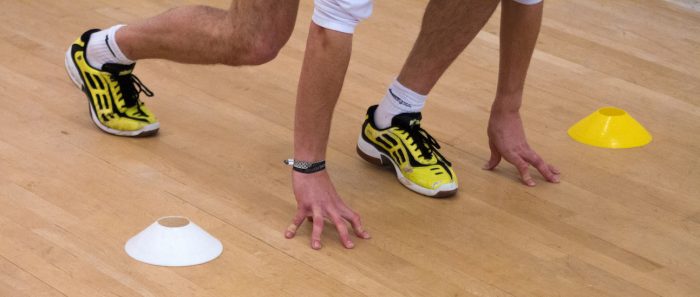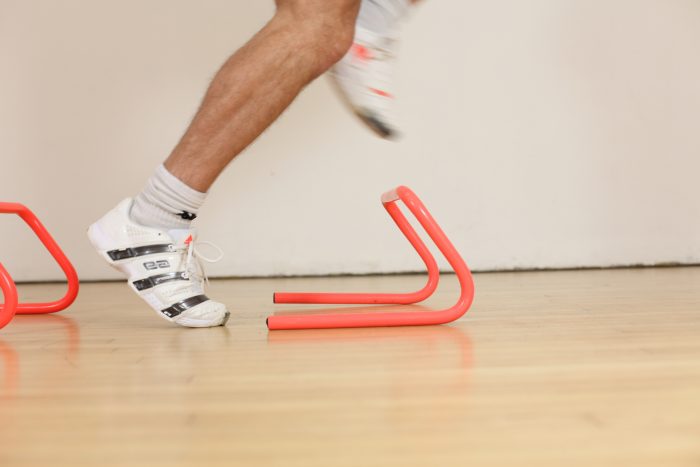We’ve had some great content on the site recently, looking at movement and how it’s such a key part of the game for so many of the most successful players. To help get you flowing around the court like the world’s best, here are our SquashSkills 3 top physical training tips for improving your on-court movement.
Build Your Power
 We’ve discussed before on the blog about the importance of power to the squash player. Most of the movements made in a game of squash involve just a few steps, or a lunge, or some kind of rapid change of direction.
We’ve discussed before on the blog about the importance of power to the squash player. Most of the movements made in a game of squash involve just a few steps, or a lunge, or some kind of rapid change of direction.
Being ‘fast’ in the traditional sporting sense where the game takes place on a larger field or playing area then, is not as important for the squash player as being explosive and able to accelerate quickly and powerfully. Speed off the mark is far more important in terms of being swift around the court in a game of squash, so power training is a key area to develop to become a better mover.
Being powerful also requires a good base of strength, an oft-forgotten attribute for the squash player. An additional benefit of training to develop this squash-specific strength and power is the increased efficiency allowed in your movement, due to the lower energy cost required for each action you take.
Develop Your Coordination
A key element that’s apparent in the very best squash movers, is the speed of their feet and their ability to make very quick short steps when approaching the ball and adjusting their position.

Footwork and coordination can often be a difficult attribute to understand how to directly train, so we’ve included a selection of some of our favourite drills on the SquashSkills Training app.
Many of our footwork and coordination sessions on the app utilise the speed/agility ladders. The ladders are used a lot in field sports such as football and rugby, to develop quick feet and movement skills. Ladder drills are also commonly used by physical therapists when working with youngsters with dyspraxia (a condition affecting physical coordination), so their benefits in developing footwork have a decent grounding in practical effect.
Being such a portable and inexpensive apparatus, it’s well worth the squash player investing in one to keep in their bag to break out for use, for a warm-up in particular – giving the double benefit of a quick burst of coordination work, along with a good general warm-up for the lower body. While impressive, some of the more elaborate drills often seen on social media video show-reels are probably a bit unnecessary, but there are a good range of more straightforward drills well worth incorporating.
Practice In Real-Time
 Along with increasing your power, and developing your footwork/coordination, it’s important to also include ‘live’ drills where you put everything together in a real-world situation to fine-tune the improvements that you’ve built.
Along with increasing your power, and developing your footwork/coordination, it’s important to also include ‘live’ drills where you put everything together in a real-world situation to fine-tune the improvements that you’ve built.
Ghosting is the most obvious squash-specific drill for developing your movement, but it’s important to approach it with the right focus. A lot of the ghosting drills we feature on the fitness side of the site have a greater emphasis on conditioning, as opposed to actual footwork patterns.
Slowing your ghosting sessions down a little to really focus on making your movements more natural and rhythmic will be of a more benefit in developing this side of your game, than just going flat-out all of the time. It can be useful to think of ghosting as almost two different exercises here – the ‘conditioning’ ghost, and the ‘technical’ ghost.
As you become more comfortable with your movements, the next stage is to start bringing the ball back into the equation and getting a coach or partner to feed you some balls at a slower pace, to really allow you to start thinking about the more technical practicalities of weight transfer, spacing, and utilising the split step. As this improves, you can then start speeding things up to a more match-specific tempo.
Gary Nisbet
B.Sc.(Hons), CSCS, NSCA-CPT, Dip. FTST
SquashSkills Fitness & Performance Director
Sign up to the SquashSkills newsletter
Get world class coaching tips, straight to your inbox!